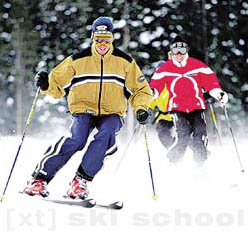|
The Pinch of Separation: Angulation
This simple concept will give you perfect alignment every time. It can be demonstrated by standing still on a steep hill while holding a ski pole across the knee caps and then across the hips. Notice how the angle of the pole matches the gradient of the slope. You should always strive to align the angles of the body. This effectively demonstrates a strong skiing position. Further, we need to drop the hip inside or toward the uphill side in order to match the same angle as the knees, but remember, always face the pelvis a little downhill. Instructors always comment that their clients are almost never angulated enough in the hips.
Once you get past the hips, the whole idea changes. The upper body always works independent of the lower body. Try to think of this golden rule: minimize upper body movements and maximize the lower body movements. The upper body should stay upright and perpendicular to the horizon, while the shoulders and hands should be even with the horizon. It is important to understand that the separation of the upper and lower body intersects at the top of the hips and this is where a pinching should be felt as the two parts of the body work independently during the turn. When skiing intermediate terrain, there should be minimal pinch, but more angulation and pinch is needed in steeper and icier terrain. The key is maintaining a straightish upper body, while angulating the lower body. Remember, they should act as two separate entities and as angulation increases, you should feel a definite pinch in the side between the hip bone and the rib cage.
Alpine Skiing School section in english version of WWW.SKI.BG is based on
"A Guide To Becoming An Expert: From First Time To A Lifetime"
by John Mukavitz Copyright © 1998

|


